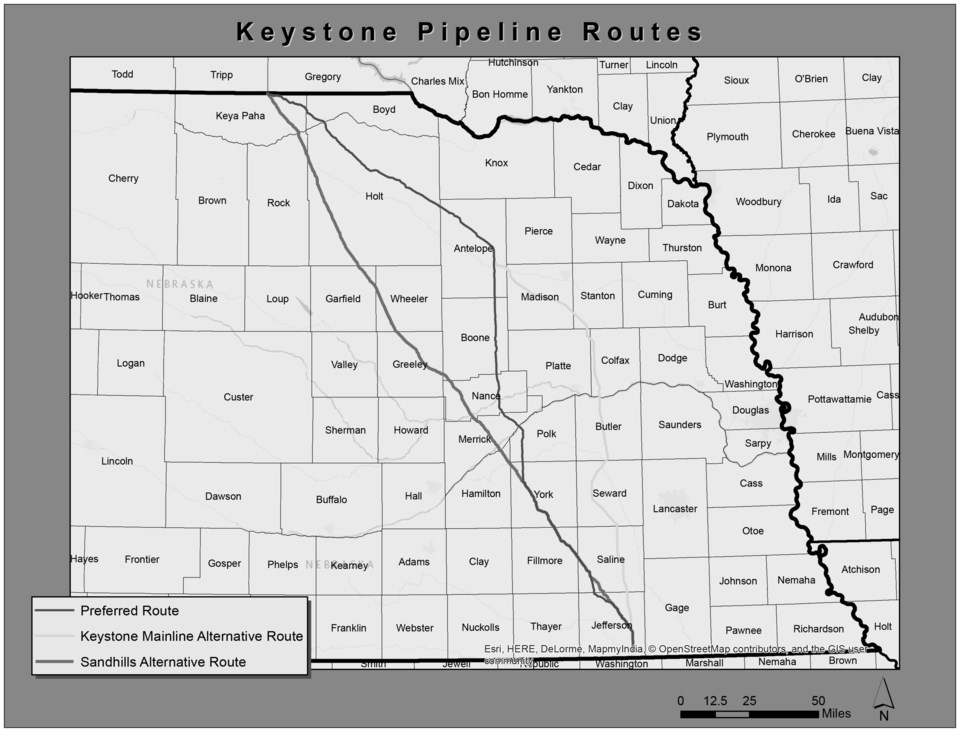Lincoln, Neb. – True to his word, newly elected U.S. President Donald Trump approved the TransCanada Keystone XL pipeline, subject to new negotiations. He did it on Jan. 24, his fourth day in office. On March 24, the project was granted a Presidential Permit.
At the time, in the Oval Office, Trump asked TransCanada president and CEO Russ Girling when construction would begin, to which Girling replied, “Well, we’ve got some work to do in Nebraska to get our permits there…”
The president said he would call the governor of Nebraska that day. However, the permit approval rested with another agency, the Nebraska Public Service Commission.
It took until Nov. 20, eight months later, for those permits to finally be granted.
In a split 3-2 decision, the Nebraska Public Service Commission ruled in favour of the pipeline application, albeit with a new route, shifted east, that varied roughly two-thirds of what TransCanada had been looking for. The “Keystone Mainline Alternative Route,” will now go through six new counties that were not part of the other two routes under consideration, meaning new landholder deals will need to be worked out and potentially a whole new wave of litigation.
The new route is along an existing transmission corridor, however.
Tension was high in the final days, however, as the original Keystone pipeline sprung a leak on Nov. 16 in neighbouring South Dakota. The spill was estimated at 5,000 barrels, which other media reported as 795,000 litres (CBC) or 210,000 gallons (New York Times).
The commission is not allowed to consider pipeline safety and spill risks under Nebraska law.
In a brief statement following the release of the approval, TransCanada said it was evaluating the Public Service Commissions’ decision. “As a result of today's decision, we will conduct a careful review of the Public Service Commission's ruling while assessing how the decision would impact the cost and schedule of the project," Girling.
Saskatchewan Premier Brad Wall was unavailable for comment at press time.
Alberta Premier Rachel Notley said in a statement, “As we stated in our submission to the Nebraska Public Service Commission, this pipeline will mean greater energy security for all North Americans by making sure people have access to Alberta’s responsibly developed energy resources.
“This is another step in our broader effort to bring more Alberta oil to the world, diversify our markets and maximize the value we as Albertans get. Today, U.S. decision makers carefully considered a pipeline and granted an approval.
“We continue to urge Canadian decision makers to follow this example so we can have access to global markets from Canadian ports, supporting good Canadian jobs. While we are very pleased with Nebraska’s approval, it underscores that Canadian regulators need to keep pace if we are going to build a truly diversified set of markets.”
The Keystone XL Pipeline Project is a proposed 1,897 km, 36-inch-diameter crude oil pipeline, beginning in Hardisty, Alta., and extending south to Steele City, Neb. The project originally ran right to the Texas Gulf Coast, but it was split several years ago and the southern portion has been built and is in operation.
While often overlooked in other media, the up to 15 per cent of the pipeline’s 830,000 bpd capacity is designated for North Dakota-produced Bakken oil, which would join the pipeline at Baker, Mont.
The right-of-way cuts across the very southwest corner of Saskatchewan, running from Burstall, right past Shaunavon and crosses the American border at Monchy. Back in July 2011, TransCanada was stockpiling pipe south of Shaunavon.




